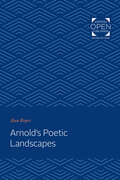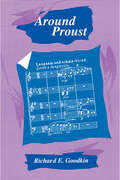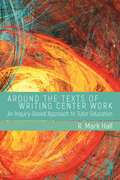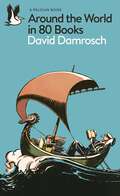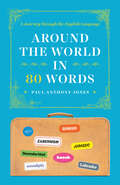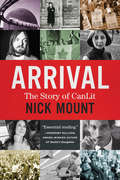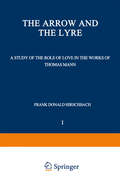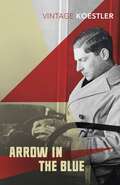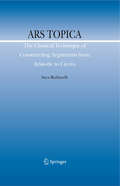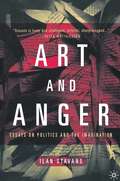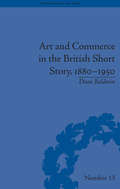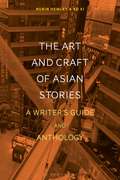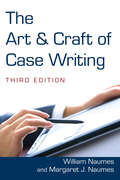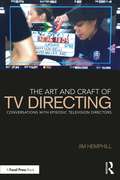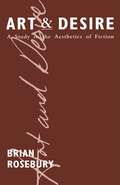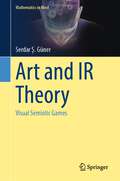- Table View
- List View
Arnold's Poetic Landscapes
by Alan RoperAlan Roper studies the degree to which Arnold achieved a unity of human significance and literal landscape. If landscape poetry is to rise above the level of what Roper calls "country contentments in verse," the poet cannot think and describe alternately; his thinking and describing must be a part of one another. That Matthew Arnold was aware of the difficulty in achieving the necessary unity becomes clear in his own criticism, which Roper examines along with a large and representative number of Arnold's poems. Considering the latter roughly in the order they were published—except for a fuller analysis of Empedocles on Etna, "The Scholar-Gipsy," and "Thyrsis"—Roper follows important changes in Arnold's view of the function and nature of poetry as it emerged in the poems themselves. Basic to the author's critical method is a distinction between geographical sites and poetic landscapes. Focusing on the ways that Arnold and, to a lesser extent, the Augustan and Romantic poets before him untied thought and description, Roper adds a critical dimension to Arnold scholarship. Concerned not with the development of Arnold's ideas nor with their sources in classical antiquity and the Romantic period, he considers Arnold a self-conscious poet who, though sometimes successful, became increasingly unsuccessful in his efforts to imbue a landscape with meaning for individual or social man.
Around Proust
by Richard E. GoodkinA study in obsession, Marcel Proust's A la recherche du temps perdu is seemingly a self-sufficient universe of remarkable internal consistency and yet is full of complex, gargantuan digressions. Richard Goodkin follows the dual spirit of the novel through highly suggestive readings of the work in its interactions with music, psychoanalysis, philosophy, and cinema, and such literary genres as epic, lyric poetry, and tragedy. In exploring this fascinating intertextual network, Goodkin reveals some of Proust's less obvious creative sources and considers his influence on later art forms. The artistic and intellectual entities examined in relation to Proust's novel are extremely diverse, coming from periods ranging from antiquity (Homer, Zeno of Elea) to the 1950s (Hitchcock) and belonging to the cultures of the Greek, French, German, and English-speaking worlds. In spite of this variety of form and perspective, all of these analyses share a common methodology, that of "digressive" reading. They explore Proust's novel not only in light of such famous passages as those of the madeleine and the good-night kiss, but also on the basis of seemingly small details that ultimately take us, like the novel itself, in unexpected directions.
Around Proust (PDF)
by Richard E. GoodkinA study in obsession, Marcel Proust's A la recherche du temps perdu is seemingly a self-sufficient universe of remarkable internal consistency and yet is full of complex, gargantuan digressions. Richard Goodkin follows the dual spirit of the novel through highly suggestive readings of the work in its interactions with music, psychoanalysis, philosophy, and cinema, and such literary genres as epic, lyric poetry, and tragedy. In exploring this fascinating intertextual network, Goodkin reveals some of Proust's less obvious creative sources and considers his influence on later art forms. The artistic and intellectual entities examined in relation to Proust's novel are extremely diverse, coming from periods ranging from antiquity (Homer, Zeno of Elea) to the 1950s (Hitchcock) and belonging to the cultures of the Greek, French, German, and English-speaking worlds. In spite of this variety of form and perspective, all of these analyses share a common methodology, that of "digressive" reading. They explore Proust's novel not only in light of such famous passages as those of the madeleine and the good-night kiss, but also on the basis of seemingly small details that ultimately take us, like the novel itself, in unexpected directions.
Around the Texts of Writing Center Work: An Inquiry-Based Approach to Tutor Education
by R. Mark HallAround the Texts of Writing Center Work reveals the conceptual frameworks found in and created by ordinary writing center documents. The values and beliefs underlying course syllabi, policy statements, website copy and comments, assessment plans, promotional flyers, and annual reports critically inform writing center practices, including the vital undertaking of tutor education. In each chapter, author R. Mark Hall focuses on a particular document. He examines its origins, its use by writing center instructors and tutors, and its engagement with enduring disciplinary challenges in the field of composition, such as tutoring and program assessment. He then analyzes each document in the contexts of the conceptual framework at the heart of its creation and everyday application: activity theory, communities of practice, discourse analysis, reflective practice, and inquiry-based learning. Around the Texts of Writing Center Work approaches the analysis of writing center documents with an inquiry stance—a call for curiosity and skepticism toward existing and proposed conceptual frameworks—in the hope that the theoretically conscious evaluation and revision of commonplace documents will lead to greater efficacy and more abundant research by writing center administrators and students.
Around the World in 80 Books (Pelican Books)
by David Damrosch'Restlessly curious, insightful, and quirky, David Damrosch is the perfect guide to a round-the-world adventure in reading' Stephen GreenblattA transporting and illuminating voyage around the globe, told through eighty classic and modern books'It is always a pleasure to talk about books with David Damrosch, who has read all of them, and he is so eloquent and understanding about them all' Orhan PamukInspired by Jules Verne's hero Phileas Fogg, David Damrosch, chair of Harvard's Department of Comparative Literature and founder of Harvard's Institute for World Literature, set out to counter a pandemic's restrictions on travel by exploring eighty exceptional books from around the globe. Following a literary itinerary from London to Venice, Tehran and points beyond, and via authors from Woolf and Dante to Nobel prizewinners Orhan Pamuk, Wole Soyinka, Mo Yan and Olga Tokarczuk, he explores how these works have shaped our idea of the world, and the ways the world bleeds into literature.To chart the expansive landscape of world literature today, Damrosch explores how writers live in two very different worlds: the world of their personal experience, and the world of books that have enabled great writers to give shape and meaning to their lives. In his literary cartography, Damrosch includes compelling contemporary works as well as perennial classics, hard-bitten crime fiction as well as haunting works of fantasy, and the formative tales that introduce us as children to the world we're entering. Taken together, these eighty titles offer us fresh perspective on perennial problems, from the social consequences of epidemics to the rising inequality that Thomas More designed Utopia to combat and the patriarchal structures within and against which many of these books' heroines have to struggle, from the work of Murasaki Shikibu a millennium ago to that of Margaret Atwood today.Around the World in 80 Books is a global invitation to look beyond ourselves and our surroundings, and to see our world and its literature in new ways.
Around the World in 80 Words: A Journey through the English Language
by Paul Anthony JonesWhat makes a place so memorable that it survives forever in a word? In this captivating round-the-world tour, Paul Anthony Jones acts as your guide through the intriguing stories of how eighty places became immortalized in the English language. You’ll discover why the origins of turkeys, limericks, Brazil nuts, and Panama hats aren’t quite as straightforward as you might presume. If you’ve never heard of the tiny Czech mining town of Jáchymov—or Joachimsthal, as it was known until the late 1800s—you’re not alone, which makes its claim to fame as the origin of the word “dollar” all the more extraordinary. The story of how the Great Dane isn’t all that Danish makes the list, as does the Jordanian mountain whose name has become a byword for a tantalizing glimpse. We’ll also find out what the Philippines has given to your office inbox, what Alaska has given to your liquor cabinet, and how a speech given by a bumbling North Carolinian gave us a word for impenetrable nonsense. Surprising, entertaining, and illuminating, this is essential reading for armchair travelers and word nerds. Our dictionaries are full of hidden histories, tales, and adventures from all over the world—if you know where to look.
Around the World in 80 Words: A Journey through the English Language
by Paul Anthony JonesWhat makes a place so memorable that it survives forever in a word? In this captivating round-the-world tour, Paul Anthony Jones acts as your guide through the intriguing stories of how eighty places became immortalized in the English language. You’ll discover why the origins of turkeys, limericks, Brazil nuts, and Panama hats aren’t quite as straightforward as you might presume. If you’ve never heard of the tiny Czech mining town of Jáchymov—or Joachimsthal, as it was known until the late 1800s—you’re not alone, which makes its claim to fame as the origin of the word “dollar” all the more extraordinary. The story of how the Great Dane isn’t all that Danish makes the list, as does the Jordanian mountain whose name has become a byword for a tantalizing glimpse. We’ll also find out what the Philippines has given to your office inbox, what Alaska has given to your liquor cabinet, and how a speech given by a bumbling North Carolinian gave us a word for impenetrable nonsense. Surprising, entertaining, and illuminating, this is essential reading for armchair travelers and word nerds. Our dictionaries are full of hidden histories, tales, and adventures from all over the world—if you know where to look.
Around the World in 80 Words: A Journey through the English Language
by Paul Anthony JonesWhat makes a place so memorable that it survives forever in a word? In this captivating round-the-world tour, Paul Anthony Jones acts as your guide through the intriguing stories of how eighty places became immortalized in the English language. You’ll discover why the origins of turkeys, limericks, Brazil nuts, and Panama hats aren’t quite as straightforward as you might presume. If you’ve never heard of the tiny Czech mining town of Jáchymov—or Joachimsthal, as it was known until the late 1800s—you’re not alone, which makes its claim to fame as the origin of the word “dollar” all the more extraordinary. The story of how the Great Dane isn’t all that Danish makes the list, as does the Jordanian mountain whose name has become a byword for a tantalizing glimpse. We’ll also find out what the Philippines has given to your office inbox, what Alaska has given to your liquor cabinet, and how a speech given by a bumbling North Carolinian gave us a word for impenetrable nonsense. Surprising, entertaining, and illuminating, this is essential reading for armchair travelers and word nerds. Our dictionaries are full of hidden histories, tales, and adventures from all over the world—if you know where to look.
Around the World in 80 Words: A Journey through the English Language
by Paul Anthony JonesWhat makes a place so memorable that it survives forever in a word? In this captivating round-the-world tour, Paul Anthony Jones acts as your guide through the intriguing stories of how eighty places became immortalized in the English language. You’ll discover why the origins of turkeys, limericks, Brazil nuts, and Panama hats aren’t quite as straightforward as you might presume. If you’ve never heard of the tiny Czech mining town of Jáchymov—or Joachimsthal, as it was known until the late 1800s—you’re not alone, which makes its claim to fame as the origin of the word “dollar” all the more extraordinary. The story of how the Great Dane isn’t all that Danish makes the list, as does the Jordanian mountain whose name has become a byword for a tantalizing glimpse. We’ll also find out what the Philippines has given to your office inbox, what Alaska has given to your liquor cabinet, and how a speech given by a bumbling North Carolinian gave us a word for impenetrable nonsense. Surprising, entertaining, and illuminating, this is essential reading for armchair travelers and word nerds. Our dictionaries are full of hidden histories, tales, and adventures from all over the world—if you know where to look.
Around the World With Ant and Bee (Ant and Bee)
by Angela BannerThese were the books that taught me how to read' Anthony Horowitz. The much-loved classic series of Ant and Bee books is designed for shared reading fun!
Arrival: The Story of CanLit
by Nick Mount“The most important book to be written in more than 40 years about the rise of Canadian literature… Arrival: The Story of CanLit brims and crackles, in equal measure, with information and energy.” — Winnipeg Free PressA Globe and Mail Top 100 BookNational Post 99 Best Books of the YearIn the mid-twentieth century, Canadian literature transformed from a largely ignored trickle of books into an enormous cultural phenomenon that produced Margaret Atwood, Alice Munro, Michael Ondaatje, Mordecai Richler, and so many others. In Arrival, acclaimed writer and critic Nick Mount answers the question: What caused the CanLit Boom?Written with wit and panache, Arrival tells the story of Canada’s literary awakening. Interwoven with Mount’s vivid tale are enlightening mini-biographies of the people who made it happen, from superstars Leonard Cohen and Marie-Claire Blais to lesser-known lights like the troubled and impassioned Harold Sonny Ladoo. The full range of Canada’s literary boom is here: the underground exploits of the blew ointment and Tish gangs; revolutionary critical forays by highbrow academics; the blunt-force trauma of our plain-spoken backwoods poetry; and the urgent political writing that erupted from the turmoil in Quebec.Originally published to coincide with the 150th anniversary of Canadian Confederation, Arrival is a dazzling, variegated, and inspired piece of writing that helps explain how we got from there to here.
The Arrow and the Lyre: A Study of the Role of Love in the Works of Thomas Mann (International Scholars Forum #1)
by Frank Donald HirschbachWhen I first thought about this topic I encountered many ex pressions of surprise among my better-read friends, and a number of them asked me: "Is there really much love in Thomas Mann's works, and is it really important?" The posing of this question is the direct result of three decades of criticism which has represented Mann mainly as a serious and sober novelist, and frequently also as a prosy and prolix author who "clutters up" his works with superfluous bits of erudition. HisMagicMountain bids fair to join the list of immortal works of world literature which people bring back from their summer vacations - unread. Mann is, of course, serious and sober and very North German in most of his works, and the charge of occasional verbosity and divagation can well be substantiated. Nevertheless, Mann has, in my opinion, tried to be fundamentally a humorist throughout his life and career, not in the conventional sense of the word in which Fritz Reuter, P. G. Wodehouse or Ring Lardner qualify, but as a man who at an astonishingly early age saw through his fellow humans, analyzed and defined their basic confiicts and decided to be a mediator, a prophet of the realm of the middle. The humor in Mann's works derives from his manner of looking at the human comedy, and our amusement is in direct proportion to our ability to discern a comic element in life, even in tragedy.
Arrow in the Blue
by Arthur KoestlerThe first volume of the remarkable autobiography of Arthur Koestler, author of Darkness at Noon.In 1931, Arthur Koestler joined the Communist Party, an event he felt to be second only in importance to his birth in shaping his destiny. Before that point, he lived a tumultuous and varied existence. He was a member of the duelling fraternity at the University of Vienna; a collective farm worker in Galilee; a tramp and street vendor in Haifa; the editor of a weekly paper in Cairo; the foreign correspondent of the biggest continental newspaper chain in Paris and the Middle East; a science editor in Berlin; and a member of the North Pole expedition of the Graf Zeppelin. Written with enormous zest, joie de vivre and frankness, Arrow in the Blue is a fascinating self-portrait of a remarkable young man at the heart of the events that shaped the twentieth century. The second volume of Arthur Koestler's autobiography is The Invisible Writing.
Ars Topica: The Classical Technique of Constructing Arguments from Aristotle to Cicero (Argumentation Library #15)
by Sara RubinelliArs Topica is the first full-length study of the nature and development of topoi, the conceptual ancestors of modern argument schemes, between Aristotle and Cicero. Aristotle and Cicero configured topoi in a way that influenced the subsequent tradition. Their work on the topos-system grew out of an interest in creating a theory of argumentation which could stand between the rigour of formal logic and the emotive potential of rhetoric. This system went through a series of developments and transformations resulting from the interplay between the separate aims of gaining rhetorical effectiveness and of maintaining dialectical standards. Ars Topica presents a comprehensive treatment of Aristotle’s and Cicero’s methods of topoi and, by exploring their relationship, it illuminates an area of ancient rhetoric and logic which has been obscured for more than two thousand years. Through an interpretation which is philologically rooted in the historical context of topoi, the book lays the ground for evaluating the relevance of the classical approaches to modern research on arguments, and at the same time provides an introduction to Greek and Roman theory of argumentation focussed on its most important theoretical achievements.
Art and Anger: Essays on Politics and the Imagination
by I. StavansFascinated by the idea of Western civilization as being a sequence of numerous misinterpretations and misrepresentations, these nineteen essays cover a broad range of topics with the unifying theme being the crossroads where politics and the imagination meet. An essay on linguistics and culture discusses the shaping of Latin America's collective identity; Peru's modern history is approached as a bloody battle between enlightenment and darkness; and in critiques of Octavio Paz and Gabriel García Márquez, Stavans reflects on the dichotomy between pen and sword in the Hispanic world. In 'Letter to a German Friend', Stavans returns to his fate as a Jew in the Southern Hemisphere, and in 'The First Book,' he connects his passion for literature to his initiation into Jewishness. Finally, in a meditation on Columbus's afterlife, he reflects on the many ways in which we reinvent ourselves in order to make sense of the chaotic world that surrounds us.
Art and Commerce in the British Short Story, 1880–1950 (The History of the Book)
by Dean BaldwinThe short story was a commercial phenomenon which took off in the late nineteenth century and lasted through to the rise of television and film. Baldwin uses a wide variety of sources to show how economic factors helped to dictate how and what a wide variety of authors wrote.
Art and Commerce in the British Short Story, 1880–1950 (The History of the Book #13)
by Dean BaldwinThe short story was a commercial phenomenon which took off in the late nineteenth century and lasted through to the rise of television and film. Baldwin uses a wide variety of sources to show how economic factors helped to dictate how and what a wide variety of authors wrote.
The Art and Craft of Asian Stories: A Writer's Guide and Anthology (Bloomsbury Writer's Guides and Anthologies)
by Robin Hemley Xu XiAn all-in-one craft guide and anthology, this is the first creative writing book to find inspiration and guidance in the diverse literary traditions of Asia. Including exemplary stories by leading writers from Japan, China, India, Singapore and beyond as well as those from Asian diasporas in Europe and America, The Art and Craft of Asian Stories offers an exciting take on the traditional how-to writing guide by drawing from a rich new trove of short stories beyond the western canon which readers may never have encountered before. Whilst still taking stock of the traditional elements of story such as character, viewpoint and setting, Xu and Hemley let these compelling stories speak for themselves to offer readers new ideas and approaches which could enrich their own creative work. Structured around the themes encountered in the stories, such as race and identity, history and power, family and aspirations, this text is a vital companion for writers at all levels keen to develop and find new perspectives on key elements of their craft.Written by two internationally successful writers and teachers, each chapter contains complete short stories and writing exercises for practice and inspiration.
The Art and Craft of Asian Stories: A Writer's Guide and Anthology (Bloomsbury Writer's Guides and Anthologies)
by Robin Hemley Xu XiAn all-in-one craft guide and anthology, this is the first creative writing book to find inspiration and guidance in the diverse literary traditions of Asia. Including exemplary stories by leading writers from Japan, China, India, Singapore and beyond as well as those from Asian diasporas in Europe and America, The Art and Craft of Asian Stories offers an exciting take on the traditional how-to writing guide by drawing from a rich new trove of short stories beyond the western canon which readers may never have encountered before. Whilst still taking stock of the traditional elements of story such as character, viewpoint and setting, Xu and Hemley let these compelling stories speak for themselves to offer readers new ideas and approaches which could enrich their own creative work. Structured around the themes encountered in the stories, such as race and identity, history and power, family and aspirations, this text is a vital companion for writers at all levels keen to develop and find new perspectives on key elements of their craft.Written by two internationally successful writers and teachers, each chapter contains complete short stories and writing exercises for practice and inspiration.
The Art and Craft of Case Writing
by William Naumes Margaret J. NaumesFilled with helpful checklists, charts, and suggestions for further reading, this practical, comprehensive, and multidisciplinary guide takes readers through the entire case-writing process, including skills for writing both teaching cases and research cases. This edition includes new discussions of students as case writers, and how to interpret and respond to reviews, as well as updated and expanded material on video, multimedia and Internet cases.
The Art and Craft of Case Writing
by William Naumes Margaret J. NaumesFilled with helpful checklists, charts, and suggestions for further reading, this practical, comprehensive, and multidisciplinary guide takes readers through the entire case-writing process, including skills for writing both teaching cases and research cases. This edition includes new discussions of students as case writers, and how to interpret and respond to reviews, as well as updated and expanded material on video, multimedia and Internet cases.
The Art and Craft of TV Directing: Conversations with Episodic Television Directors
by Jim HemphillThe Art and Craft of TV Directing offers a broad and in-depth view of the craft of TV Directing in the form of detailed interviews with dozens of the industry’s most accomplished episodic television directors.Author Jim Hemphill provides students with essential information on the complexities of working in episodic TV, highlighting the artistic, technical, and interpersonal skills required, and exploring a variety of entry points and approaches to provide a comprehensive overview of how to begin and sustain a career as a television director. The book discusses how to merge one’s personal style with the established visual language of any given show, while also adhering to tight budgets and schedules and navigating the complicated politics of working with showrunners, networks, and producers. The book also features interviews with a range of directors, from feature directors who have moved into episodic TV (Kimberly Peirce, Mark Pellington) to directors who have made the transition from other disciplines like acting (Andrew McCarthy, Lea Thompson), hair and makeup (Stacey K. Black) and stunts (David M. Barrett).This book provides unprecedented access to the experiences and advice of contemporary working episodic television directors, and is an ideal resource for students studying television directing, early career professionals looking for advice, and working directors looking to make the transition from feature directing to episodic TV directing.
The Art and Craft of TV Directing: Conversations with Episodic Television Directors
by Jim HemphillThe Art and Craft of TV Directing offers a broad and in-depth view of the craft of TV Directing in the form of detailed interviews with dozens of the industry’s most accomplished episodic television directors.Author Jim Hemphill provides students with essential information on the complexities of working in episodic TV, highlighting the artistic, technical, and interpersonal skills required, and exploring a variety of entry points and approaches to provide a comprehensive overview of how to begin and sustain a career as a television director. The book discusses how to merge one’s personal style with the established visual language of any given show, while also adhering to tight budgets and schedules and navigating the complicated politics of working with showrunners, networks, and producers. The book also features interviews with a range of directors, from feature directors who have moved into episodic TV (Kimberly Peirce, Mark Pellington) to directors who have made the transition from other disciplines like acting (Andrew McCarthy, Lea Thompson), hair and makeup (Stacey K. Black) and stunts (David M. Barrett).This book provides unprecedented access to the experiences and advice of contemporary working episodic television directors, and is an ideal resource for students studying television directing, early career professionals looking for advice, and working directors looking to make the transition from feature directing to episodic TV directing.
Art and IR Theory: Visual Semiotic Games (Mathematics in Mind)
by Serdar Ş. GünerThis book examines the correspondence between international relations (IR) theories of structural realism and constructivism and paintings, notably the artwork of Mark Rothko and Jackson Pollock, in a game theory setting. This interdisciplinary approach, through the lens of game theory and semiotics, permits different, enriched interpretations of structural realism and constructivism. These theories constitute an axis of debate between social and systemic approaches to international politics, as well as an axis of differentiation between scientific realism and positivism as philosophies of science. As such, the interpretations explored in this book contribute to what we know about international relations, how semiotics intersect with strategic uncertainty, and explains these interactions in the proposed games model.The book’s use of game theory and semiotics generate ‘visual semiotic games’ (VSGs) that shed light on the debate axes through strategic uncertainty, interactions, and players’ interactive belief systems. VSGs will contribute to literature on experimental semiotics in the sense of players’ coordination behavior, beliefs, and artistic evaluations. The equilibria, interpreted through branches of philosophy of mind and theories of explanation, will reveal possibilities of agreement among players about which artwork representing the theory at hand is the best, opening innovative research perspectives for the discipline of IR theory.
